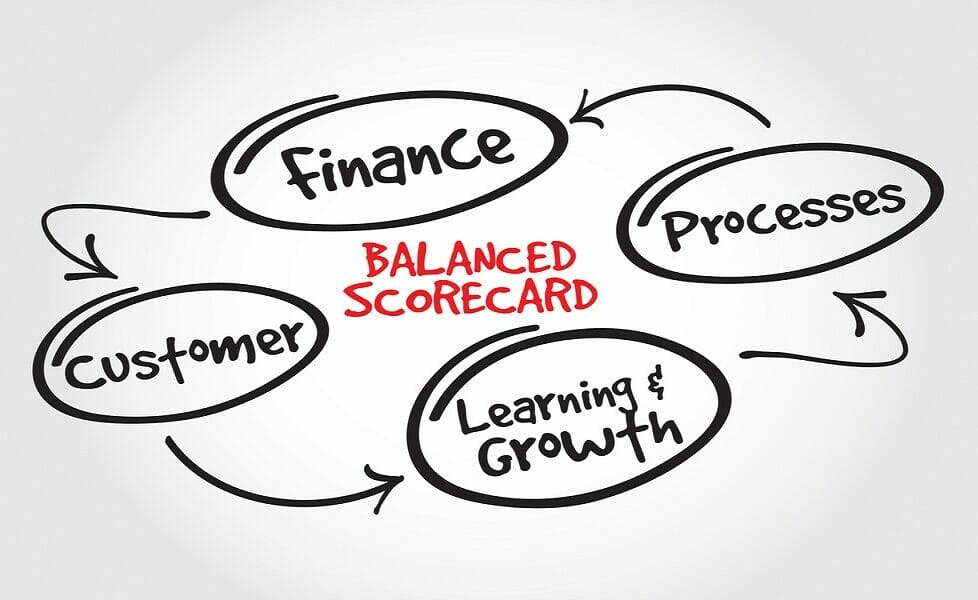Improve Your Strategic Journey With A Balanced Scorecard


LINKS TO CONTENT
ToggleA balanced scorecard is a management tool that is used to measure and monitor a company’s performance across different areas. It is a strategic planning and management system that helps companies align their activities with their mission and vision. It helps communicate their objectives to stakeholders. The balanced scorecard approach was first introduced in the early 1990s by Drs. Robert Kaplan and David Norton. It has since become a popular method for companies to manage their performance.
The balanced scorecard approach recognizes that a company’s performance is not just about financial results. There are other equally important areas such as customer satisfaction, internal processes, and employee learning and growth. The balanced scorecard approach divides a company’s activities into four perspectives. These are financial, customer, internal processes, and learning and growth. Each perspective is then assigned key performance indicators (KPIs). The KPIs are specific, measurable, achievable, relevant, and time-bound (SMART).
The financial perspective is the most traditional. It focuses on the financial results of a company. The KPIs in this perspective typically include revenue growth, profitability, return on investment, and cash flow. These measures are important to ensure that a company is financially sustainable and profitable in the long term.
The customer perspective focuses on the needs and expectations of the company’s customers. The KPIs in this perspective typically include customer satisfaction, customer retention, and market share. These measures are important to ensure that a company is meeting the needs of its customers and retaining their loyalty.
The internal processes perspective focuses on the internal processes of a company that contribute to the delivery of products or services to customers. The KPIs in this perspective typically include cycle time, process efficiency, and quality. These measures are important to ensure that a company is delivering products and services efficiently and effectively.
The learning and growth perspective focuses on the company’s ability to learn and innovate in order to remain competitive. The KPIs in this perspective typically include employee satisfaction, employee development, and innovation. These measures are important to ensure that a company is continuously improving and innovating to stay ahead of its competitors.
By using the balanced scorecard approach, a company can ensure that it is focusing on all four perspectives of its business, not just the financial perspective. This helps companies to be more well-rounded. It encourages them to take a more holistic approach to their operations. By monitoring the KPIs for each perspective, companies can identify areas where they need to improve and take corrective action.
One of the benefits of using the balanced scorecard approach is that it helps companies to communicate their strategy and objectives to all stakeholders. By having a clear set of KPIs for each perspective, companies can ensure that everyone is working towards the same goals. This can help to align the efforts of employees, managers, and executives. It also creates a more cohesive and effective organization.
Another benefit of using the balanced scorecard approach is that it helps companies to measure the success of their strategy over time. By monitoring the KPIs for each perspective on a regular basis, companies can identify trends and patterns in their performance. This can help them to make adjustments to their strategy in real time. It ensures they are always on track to achieve their goals.
In addition to these benefits, the balanced scorecard approach can also help companies to improve their overall performance. By monitoring the KPIs for each perspective, companies can identify areas where they need to improve and take corrective action. This can help to improve the quality of products and services, increase customer satisfaction, and reduce costs.
However, there are some potential drawbacks to using the balanced scorecard approach. One potential issue is that it can be difficult to develop and implement a balanced scorecard that is tailored to the specific needs of a company. This requires a deep understanding of the company’s operations, objectives, and stakeholders, as well as the ability to develop SMART KPIs that are relevant to each perspective.
Another potential issue is that the balanced scorecard approach can be complex and time-consuming to implement. It requires regular monitoring and reporting of KPIs, as well as the ability to analyze and interpret data in order to make informed decisions. This can be a significant investment of time and resources for a company, especially if it is a small or medium-sized business.
Despite these potential drawbacks, the balanced scorecard approach remains a popular and effective management tool for many companies. It provides a framework for companies to measure and monitor their performance across different areas, and to communicate their objectives to stakeholders. By using the balanced scorecard approach, companies can ensure that they are taking a more well-rounded approach to their operations, and not just focusing on financial performance.
In conclusion, the balanced scorecard approach is a valuable tool for companies that want to improve their performance across different areas. By using this approach, companies can develop a set of SMART KPIs for each perspective, and monitor their performance on a regular basis. This can help them to identify areas where they need to improve and take corrective action to ensure that they are always on track to achieve their goals. While there are some potential drawbacks to using the balanced scorecard approach, the benefits outweigh the costs for many companies. If you are looking for a management tool that can help you to align your activities with your mission and vision, and monitor your performance across different areas, the balanced scorecard approach is definitely worth considering.
I help leaders develop self- mastery, helping them to become confident in their own inner guidance.
I collaborate with leadership experts, managers and HR professionals to help them get their own message and unique services and products to a wide audience.
